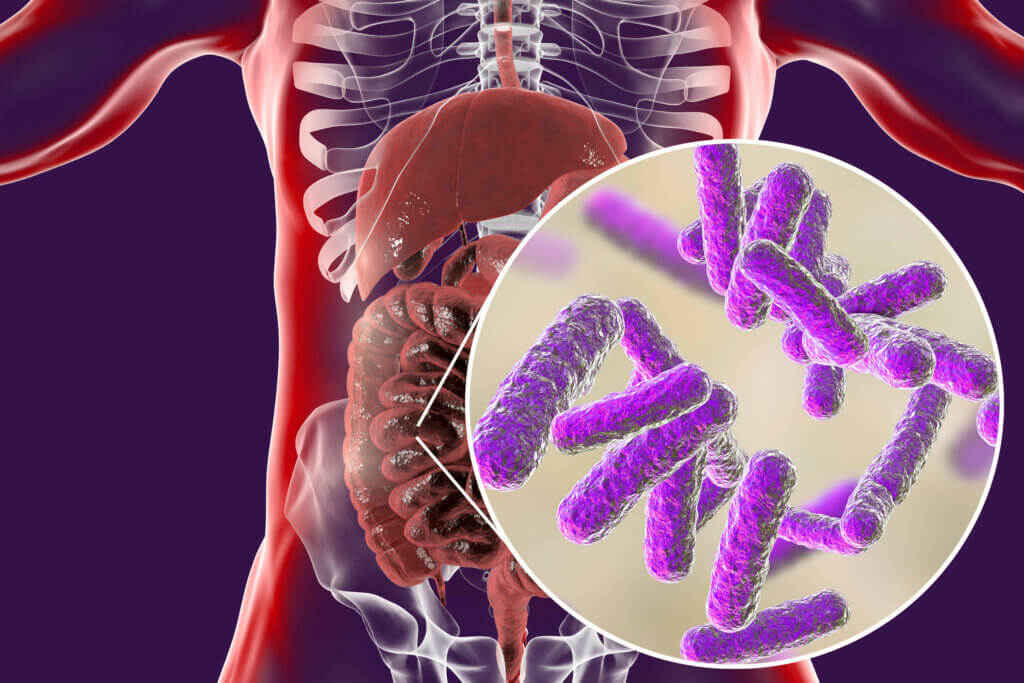The 3 Types of Microbiota and Their Characteristics

The group of microorganisms that live in a specific environment is known as microbiota. The human microbiota are all viruses, bacteria, fungi, and archaea that live in different parts of the body. According to research, a healthy person has between 10 and 100 billion organisms of this type, most of them in a symbiotic relationship. We’ll look at the types of microbiota in this article.
Cataloging the types of microbiota isn’t an easy task. It isn’t known with certainty, although it’s estimated that more than 5000 species of microorganisms coexist at the same time. We’ll now explain three divisions based on their repercussions for humans.
Types of microbiota
1. Beneficial microbiota
The beneficial types of microbiota fulfill an essential function for health. They’re found in all parts of the body, but, in this case, we will focus on those that are housed in the gastrointestinal system.
The evidence attributes three main functions to these variants: metabolic and nutritional, protective, and immune control. Let’s look at this in more detail.
Metabolic and nutritional functions
The intestinal flora helps to metabolize substrates and residues of the diet that haven’t been digested in the stomach or intestine. The body provides them with food and, as a gift, the microbiota provides enzymes and biochemical pathways essential for the metabolic and nutritional process.
For example, some microorganisms produce biotin, vitamin B12, vitamin K, and folic acid. Although there are hundreds, the most common are Lactobacillus and Bifidobabacterium. They’re often taken as probiotics, especially in patients with irritable bowel syndrome or ulcerative colitis (among other conditions).

Protective functions
In turn, the microbiota of this type can also have a guardian effect. Just as an army would, they prevent other types of microorganisms from altering the ecosystem.
They do this not only to favor their host, but also for their own survival. In a limited environment, the fight for resources is a daily battle. Some microorganisms fulfill this function by releasing bacteriocin, a kind of antibiotic that inhibits the growth of peripheral strains.
Trophic function
To help support the immune system, some bacteria control epithelial cell secretion in perfect balance. Animals raised in aseptic conditions develop fewer of these cells than those with normal intestinal flora. They can also control the balance of lymphoid cell production.
Sometimes they release messengers that alert the immune system to an intruder that they can’t control. All of the above results in a homeostasis between the microorganisms and the health of their host.
In this sense, the types of beneficial microbiota are those that you want to have in your body. You provide them with food and a place to live, and they reward you with these three functions.
2. Opportunistic microbiota
Opportunistic microbiota are microorganisms that, without proper control, are capable of making you sick. In the previous case, they live, feed and die without causing further damage. Opportunists, on the other hand, wait for the slightest bit of weakness to cause trouble.
This isn’t their main function, although they do act if the immune system is weak or the protective bacteria aren’t doing their job. They can live in your body for weeks, months, years, or decades without major incidents.
Researchers point to the following among the main components of this type of microbiota:
- Yersinia
- Pseudomonas aeruginosa
- Clostridium
- Candida
- Salmonella.
- Helicobacter pylori
Adenovirus and retrovirus, among others, also live by billions in your body without causing you a single symptom. This, at least until they find the opportunity.
3. Commensal microbiota
Finally, we find the commensal microbiota. This type is characterized by being harmless and impartial. They aren’t essential for your body’s processes, but neither can they cause you illnesses.
This kind of balance is really only apparent. The commensal microbiota can perform functions that control some aspects of the organism. For example, sending messages that alter your behavior to benefit from its consequences.
Research indicates that they can cause stress, anxiety, and even memory disturbances. They can also control your appetite, encouraging the intake of some foods that are preferred by them.

The complex world of the different types of microbiota
Keep in mind that this is only an outline of the types of microbiota. We haven’t mentioned the microbiomes, the way they acquire organisms, or their specific functions in areas such as the eye, the skin, the mucous membranes, the ear, and the genitals. The network is certainly a very complex one.
The group of microorganisms that live in a specific environment is known as microbiota. The human microbiota are all viruses, bacteria, fungi, and archaea that live in different parts of the body. According to research, a healthy person has between 10 and 100 billion organisms of this type, most of them in a symbiotic relationship. We’ll look at the types of microbiota in this article.
Cataloging the types of microbiota isn’t an easy task. It isn’t known with certainty, although it’s estimated that more than 5000 species of microorganisms coexist at the same time. We’ll now explain three divisions based on their repercussions for humans.
Types of microbiota
1. Beneficial microbiota
The beneficial types of microbiota fulfill an essential function for health. They’re found in all parts of the body, but, in this case, we will focus on those that are housed in the gastrointestinal system.
The evidence attributes three main functions to these variants: metabolic and nutritional, protective, and immune control. Let’s look at this in more detail.
Metabolic and nutritional functions
The intestinal flora helps to metabolize substrates and residues of the diet that haven’t been digested in the stomach or intestine. The body provides them with food and, as a gift, the microbiota provides enzymes and biochemical pathways essential for the metabolic and nutritional process.
For example, some microorganisms produce biotin, vitamin B12, vitamin K, and folic acid. Although there are hundreds, the most common are Lactobacillus and Bifidobabacterium. They’re often taken as probiotics, especially in patients with irritable bowel syndrome or ulcerative colitis (among other conditions).

Protective functions
In turn, the microbiota of this type can also have a guardian effect. Just as an army would, they prevent other types of microorganisms from altering the ecosystem.
They do this not only to favor their host, but also for their own survival. In a limited environment, the fight for resources is a daily battle. Some microorganisms fulfill this function by releasing bacteriocin, a kind of antibiotic that inhibits the growth of peripheral strains.
Trophic function
To help support the immune system, some bacteria control epithelial cell secretion in perfect balance. Animals raised in aseptic conditions develop fewer of these cells than those with normal intestinal flora. They can also control the balance of lymphoid cell production.
Sometimes they release messengers that alert the immune system to an intruder that they can’t control. All of the above results in a homeostasis between the microorganisms and the health of their host.
In this sense, the types of beneficial microbiota are those that you want to have in your body. You provide them with food and a place to live, and they reward you with these three functions.
2. Opportunistic microbiota
Opportunistic microbiota are microorganisms that, without proper control, are capable of making you sick. In the previous case, they live, feed and die without causing further damage. Opportunists, on the other hand, wait for the slightest bit of weakness to cause trouble.
This isn’t their main function, although they do act if the immune system is weak or the protective bacteria aren’t doing their job. They can live in your body for weeks, months, years, or decades without major incidents.
Researchers point to the following among the main components of this type of microbiota:
- Yersinia
- Pseudomonas aeruginosa
- Clostridium
- Candida
- Salmonella.
- Helicobacter pylori
Adenovirus and retrovirus, among others, also live by billions in your body without causing you a single symptom. This, at least until they find the opportunity.
3. Commensal microbiota
Finally, we find the commensal microbiota. This type is characterized by being harmless and impartial. They aren’t essential for your body’s processes, but neither can they cause you illnesses.
This kind of balance is really only apparent. The commensal microbiota can perform functions that control some aspects of the organism. For example, sending messages that alter your behavior to benefit from its consequences.
Research indicates that they can cause stress, anxiety, and even memory disturbances. They can also control your appetite, encouraging the intake of some foods that are preferred by them.

The complex world of the different types of microbiota
Keep in mind that this is only an outline of the types of microbiota. We haven’t mentioned the microbiomes, the way they acquire organisms, or their specific functions in areas such as the eye, the skin, the mucous membranes, the ear, and the genitals. The network is certainly a very complex one.
- Guarner, F. Papel de la flora intestinal en la salud y en la enfermedad. Nutrición hospitalaria. 2007; 22, 14-19.
- Martínez JL. Short-sighted evolution of bacterial opportunistic pathogens with an environmental origin. Front Microbiol. 2014 May 20;5:239.
- Carabotti M, Scirocco A, Maselli MA, Severi C. The gut-brain axis: interactions between enteric microbiota, central and enteric nervous systems. Ann Gastroenterol. 2015 Apr-Jun;28(2):203-209.
- Ursell, L. K., Metcalf, J. L., Parfrey, L. W., & Knight, R. Defining the human microbiome. Nutrition reviews. 2012; 70: 38-S44.
Este texto se ofrece únicamente con propósitos informativos y no reemplaza la consulta con un profesional. Ante dudas, consulta a tu especialista.







